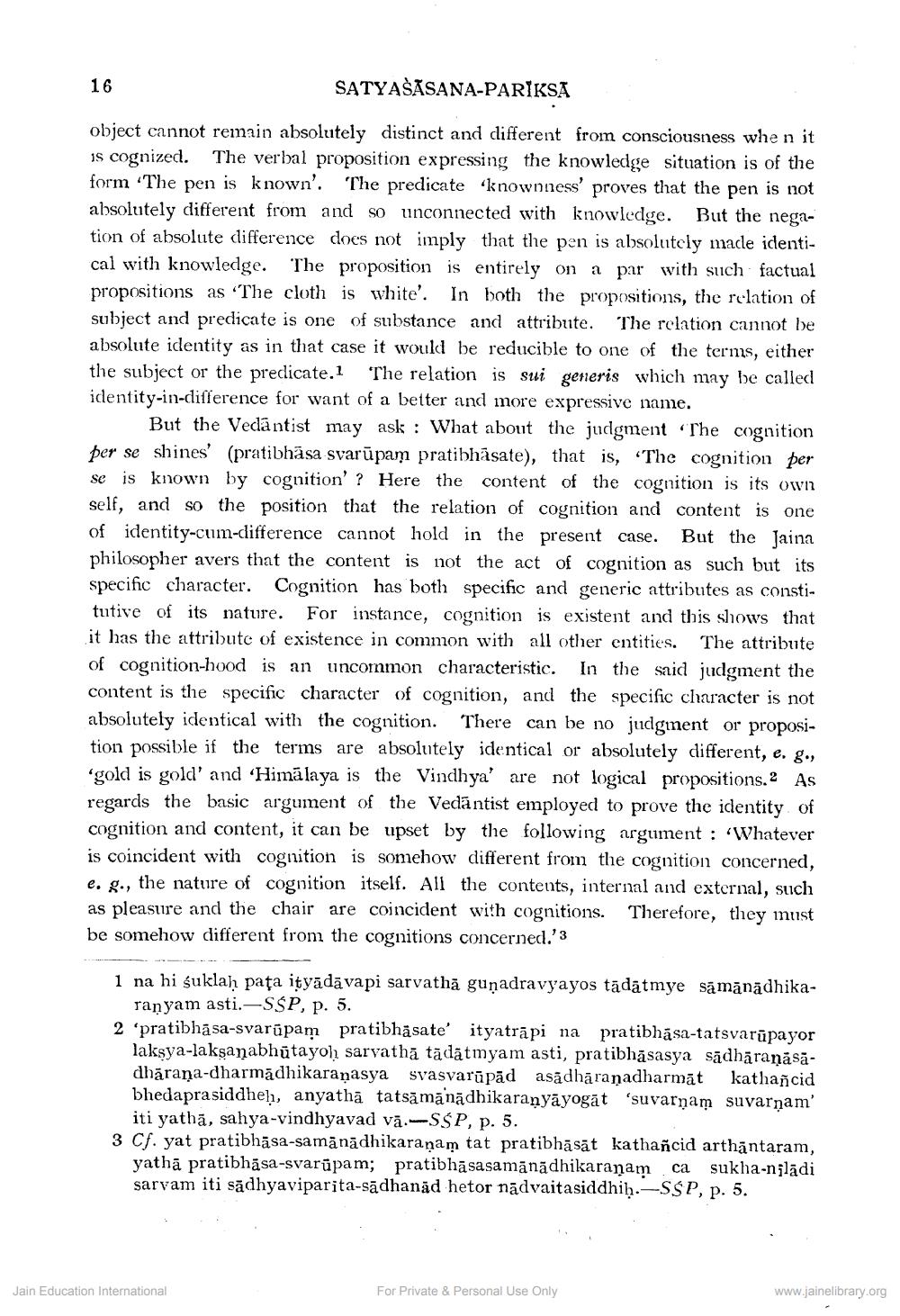________________
SATYASASANA-PARIKSA
object cannot remain absolutely distinct and different from consciousness when it is cognized. The verbal proposition expressing the knowledge situation is of the form 'The pen is known'. The predicate knownness' proves that the pen is not absolutely different from and so unconnected with knowledge. But the negation of absolute difference does not imply that the pen is absolutely made identical with knowledge. The proposition is entirely on a par with such factual propositions as 'The cloth is white'. In both the propositions, the relation of subject and predicate is one of substance and attribute. The relation cannot be absolute identity as in that case it would be reducible to one of the terms, either the subject or the predicate.1 The relation is sui generis which may be called identity-in-difference for want of a better and more expressive name.
16
But the Vedantist may ask: What about the judgment "The cognition per se shines' (pratibhasa svarupam pratibhasate), that is, "The cognition per se is known by cognition'? Here the content of the cognition is its own self, and so the position that the relation of cognition and content is one of identity-cum-difference cannot hold in the present case. But the Jaina philosopher avers that the content is not the act of cognition as such but its specific character. Cognition has both specific and generic attributes as constitutive of its nature. For instance, cognition is existent and this shows that it has the attribute of existence in common with all other entities. The attribute of cognition-hood is an uncommon characteristic. In the said judgment the content is the specific character of cognition, and the specific character is not absolutely identical with the cognition. There can be no judgment or proposition possible if the terms are absolutely identical or absolutely different, e. g., 'gold is gold' and 'Himalaya is the Vindhya' are not logical propositions. As regards the basic argument of the Vedantist employed to prove the identity of cognition and content, it can be upset by the following argument: 'Whatever is coincident with cognition is somehow different from the cognition concerned, e. g., the nature of cognition itself. All the contents, internal and external, such as pleasure and the chair are coincident with cognitions. Therefore, they must be somehow different from the cognitions concerned.'3
1 na hi suklah pata iṭyadavapi sarvatha gunadravyayos tādātmye samānādhikaranyam asti.-SSP, p. 5.
2 'pratibhasa-svarupam pratibhasate' ityatrapi na pratibhasa-tatsvarūpayor lakṣya-lakṣaṇabhūtayoḥ sarvatha tādātmyam asti, pratibhasasya sadhāraṇāsādhāranṇa-dharmadhikaraṇasya svasvarūpād asādharaṇadharmāt kathañcid bhedaprasiddheḥ, anyatha tatsāmānādhikaranyāyogat 'suvarnam suvarṇam' iti yatha, sahya-vindhyavad va.-SSP, p. 5.
3 Cf. yat pratibhasa-samānādhikaranam tat pratibhāsāt kathañcid arthantaram, yatha pratibhasa-svarūpam; pratibhasasamānādhikaranam ca sukha-niladi sarvam iti sadhyaviparita-sādhanad hetor nadvaitasiddhiḥ.-SSP, p. 5.
Jain Education International
For Private & Personal Use Only
www.jainelibrary.org




